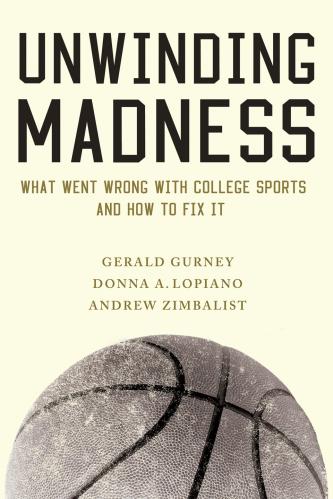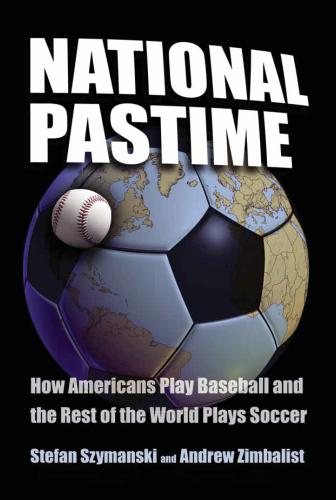With March Madness in full swing, it can be easy to overlook an important question: Has the NCAA lost sight of its responsibilities to students?
 In the new Brookings Press book “Unwinding Madness: What Went Wrong with College Sports—and How to Fix It,” authors Gerald Gurney, Donna Lopiano, and Andrew Zimbalist argue that the NCAA has placed commercial success above academics and the well-being of college athletes. The authors state that the organization is incapable of achieving reform and must be replaced.
In the new Brookings Press book “Unwinding Madness: What Went Wrong with College Sports—and How to Fix It,” authors Gerald Gurney, Donna Lopiano, and Andrew Zimbalist argue that the NCAA has placed commercial success above academics and the well-being of college athletes. The authors state that the organization is incapable of achieving reform and must be replaced.
To learn more about the educational, economic, and ethical issues in college athletics, we asked the authors to answer a few questions on the state of the NCAA.
Are operating costs becoming a serious issue for school athletics programs?
Andrew Zimbalist: Yes, the median FBS [Football Bowl Subdivision, i.e., the top level of U.S. college football] athletic department had an operating loss of $12.7 million in fiscal year 2015. If capital costs are added in, the loss can easily exceed $30 million at a majority of schools.
The smaller schools in FBS struggle to keep up with the strongest teams in the Power Five conferences [Big East, ACC, Big 12, Big Ten, Pac-12], leading them to spend comparable amounts on coaches, facilities and amenities.
With rare exception, however, they can’t compete on the field or court, so revenues do not keep pace. These schools face massive and growing deficits with scant prospect for success.
How do basketball and football compare in terms of revenue for schools?
Andrew Zimbalist: According to the NCAA’s statistics, during the fiscal year 2015 (the latest year available) the highest revenues in FBS (the most commercialized subdivision in college sports with 128 schools) generated by a football team was $120.7 million and by a basketball team $45.8 million. The median football revenue in FBS was $21.6 million, while that in basketball was $5.7 million.
So, depending on the measurement, football revenue was between 2.7 and 3.8 times larger than basketball revenue.
Are exorbitant salaries for college football and basketball coaches becoming a problem that the NCAA needs to address?
Andrew Zimbalist: Yes, they are economically unjustified and ethically problematic.
Head coaches on the top college men’s basketball and football teams are paid as much as those in the NBA and NFL, even though the NBA and NFL teams earn five to ten times as much revenue on average. The coaches (and athletic directors and conference commissioners) are being paid the revenue that is produced by the players because the players are not allowed to be paid.
The former venerated coach of the Alabama football team, Bear Bryant, had it right. Bryant refused to be paid more than one dollar less than what the college president was paid because it would send the wrong signal to the students about what the college valued.
Should a “death penalty” for a school sports program ever be put in place for university or student misconduct?
Gerald Gurney: The repeat offender’s rule, otherwise known as “the death penalty,” has only been applied once, at Southern Methodist University [canceling the 1987 season]. The penalty devastated the reputation of the university as well as the athletics program.
After 30 years, its football program continues to wallow in mediocrity and the university is currently under a major infractions sanction. Since 1986, the NCAA’s Committee on Infractions has shown a reluctance to levy the penalty again. Having fallen into disuse, the death penalty has been ineffective in curbing the widespread cheating in intercollegiate athletics.
New rules targeting coaches may be effective in curbing the corruptive atmosphere, but until accrediting agencies impose heavy sanctions on institutions for failure to control athletics programs, there is little deterrent to reduce misconduct.
What kind of gaps exist in medical coverage for student-athletes?
Donna Lopiano: Contrary to public perception, while the NCAA provides a catastrophic injury policy, schools do not provide basic athletic injury insurance for their athletes.
Rather, as a condition of participation, the school requires that the athlete’s parents or the athlete provide a basic insurance policy. The school just provides secondary coverage and dependent on its financial ability has the OPTION to pay for deductibles, uncovered procedures, etc. Commonly, most of these policies are limited in that they do not cover medical procedures more than two years removed from the athlete exiting the program … thus leaving the athlete or his/her family financially exposed for the long term effects of concussion or other injuries.
Further, for athletes seeking to pursue a professional sports career NCAA rules limit the number of athletes eligible for the NCAA Exceptional Athlete Disability Program, which requires the athlete to pay for such insurance as well as Loss of Value insurance.
Listen to a Brookings Cafeteria podcast interview about the book with Donna Lopiano:
The Brookings Institution is committed to quality, independence, and impact.
We are supported by a diverse array of funders. In line with our values and policies, each Brookings publication represents the sole views of its author(s).



Commentary
Unwinding Madness: Experts break down key issues facing the NCAA today
March 16, 2017